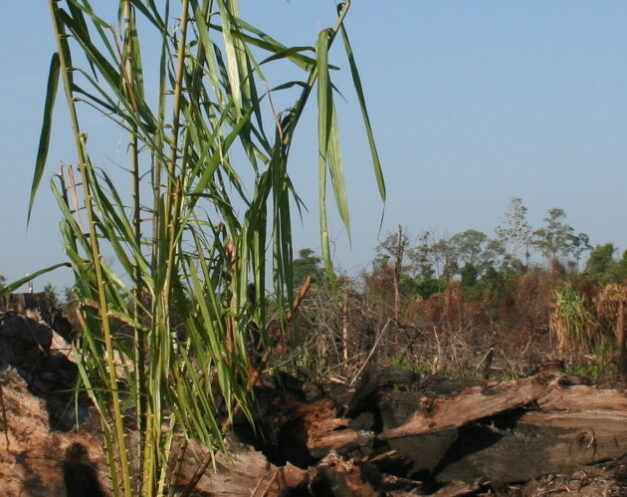Towards sustainable palm oil

Approximately 90% of world palm oil production takes place in Indonesia and Malaysia. Of these plantations around 20% is grown on peat soils, which used to be covered by peat swamp forests. The drainage of these carbon-rich organic soils for plantations leads to massive CO2 emissions, soil subsidence, and ecological and social problems. We aim for sustainable palm oil.
Our immediate objectives are to stop the expansion of oil palm production on peatlands and reduce the impacts of existing plantations on peat. In the long term, our aim is to exclude all palm oil production on peatlands and realise the conservation, restoration and wise use of peatlands.
Rapid expansion of oil palm plantations on peatlands
Peat swamps are sparsely populated areas in Indonesia and Malaysia and are for this reason popular for establishing large plantations. The ambition to use palm oil as a biofuel adds to the existing demand for palm oil as a food oil.
Around 20% of all oil palm plantations in Southeast Asia are on peat. Sumatra has the largest absolute extent of oil palm plantations on peat (1.3 Mha), followed by Sarawak (717,830), Kalimantan (730750 ha), and Peninsular Malaysia (275,680 ha). The highest oil palm development rates on peat are in Sarawak: the rate of change in the last temporal period of swamp forest in Sarawak was approximately 7% annually (59,620 ha) and nearly all of the loss of peat forest can be directly attributed to establishment of new oil palm plantations.
From plantation to wasteland
Peatlands are not very suitable for oil palm production; soil fertility is poor and far too wet for these trees. Therefore they are being logged and drained.
This however leads to carbon dioxide emissions, soil subsidence and to the rapid loss of biodiversity, including unique species such as the Sumatran Orangutan, Sumatran Tiger and Sumatran Rhinoceros.
Given that Indonesia has over 3 million hectares of palm oil plantations and a similar amount of smallholder plantations on peat, drainage for palm oil is, using conservative estimates, causing emissions of 438 million tonnes of carbon dioxide per year. With harvests of 2-6 tonnes of palm oil per hectare, palm oil is causing carbon dioxide emissions 10 times the magnitude of fossil fuels.
Plantations established on drained peatland often turn into wastelands. In coastal areas, when the peat soils have ‘evaporated’ and subsided, further drainage becomes impossible and saltwater intrudes into the now low-lying areas.
What we do
We raise awareness of the adverse consequences of palm oil plantations on peatlands and help to transform the sector towards sustainable palm oil. We do this by developing knowledge together with our partners, sharing this with our network and advocating for policy changes.
- Wetlands International has been a critical member of the Roundtable on Sustainable Palm Oil (RSPO) since 2007. The aim of RSPO is to promote the growth and use of sustainable palm oil. See Wetlands International’s Annual Communication Of Progress (ACOP) 2013/2014.
- In Europe, we highlight the weakness of palm oil as a sustainable alternative for conventional fuels.
- At the UN Climate Change Convention we advocate for incentives for better peatland management.
Our successes:
- In 2008, the German and Dutch governments banned palm oil from their subsidies for green energy production.
- As a result of our advocacy, the EU has included criteria in the Renewable Energy Directive to prevent biofuel production at the expense of wetlands and peatlands.
- As a member of the RSPO, we realised the establishment of a committee to develop criteria to prevent wetlands loss and the Greenhouse Gas working group of the RSPO. The Peatland Working Group drafted Best Management Practice guidelines for existing plantations on peat and a scientific review for the sector’s impacts on peatlands, including a scientific review led by Wetlands International on greenhouse gas emissions related to peatland drainage.
- In 2011, the Indonesian government initiated a two year moratorium on new concessions in forest areas and areas with peat soils (nearly 30 million hectares were identified). This Moratorium was renewed in 2013. The extension will be valid for a period of 2 years.
RSPO
In April 2013, the RSPO adopted a new set of Principles and Criteria, including for the production of palm oil on peat. For growers with existing plantations on peat it basically signifies the need to carry out long-term drainability assessments and to pro-actively remove these plantations well before they are hit by flooding and land loss. The RSPO also requires the avoidance of peatlands in new plantation developments and recommends reconsideration of replanting two crop cycles before the drainage limit is reached. Wetlands International has drafted a manual for growers to enable and stimulate growers to adjust their planning and practices.
